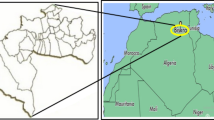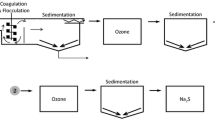Abstract
In this study, dissolved air flotation (DAF) was examined as a possible treatment method for the removal of chromium from aqueous solution and plating wastewater. Two coagulants, ferric chloride and poly aluminum chloride (PAC), were used for pretreatment of wastewater. Maximum removal of chromium was achieved for poly aluminum chloride (98 %). Artificial neural network was used for the prediction of the DAF system. The best neuron used for the prediction of chromium removal percentage of interpolated wastewater was 6 %. The mean score error and the coefficient correlation were 0.0007542 and 0.997, respectively.




Similar content being viewed by others
References
Cybenko, G. (1992). Approximation by superpositions of a sigmoidal function. Mathematics of Control, Signals, and Systems MCSS, 5(4), 455–455.
De Nardi, I., Fuzi, T., & Del Nery, V. (2008). Performance evaluation and operating strategies of dissolved-air flotation system treating poultry slaughterhouse wastewater. Resources, Conservation and Recycling, 52(3), 533–544.
El-Gohary, F., Tawfik, A., & Mahmoud, U. (2010). Comparative study between chemical coagulation/precipitation (C/P) versus coagulation/dissolved air flotation (C/DAF) for pre-treatment of personal care products (PCPs) wastewater. Desalination, 252(1), 106–112.
Féris, L. A. (2003). Processo FPS, inovação na remoção de metais pesados em águas poluídas usando rejeitos de carvão e flotação. CNPq: XIX Prémio Jovem Cientista. Brasília.
Fu, F., & Wang, Q. (2011). Removal of heavy metal ions from wastewaters: a review. Journal of Environmental Management, 92(3), 407–418.
Jorjani, E., Chehreh Chelgani, S., & Mesroghli, S. (2007). Prediction of microbial desulfurization of coal using artificial neural networks. Minerals Engineering, 20(14), 1285–1292.
Krofta, M., Herath, B., Burgess, D., & Lampman, L. (1995). An attempt to understand dissolved air flotation using multivariate data analysis. Water Science and Technology, 31(3), 191–201.
Kurama, H., Karagüzel, C., Mergan, T., & Çelik, M. (2010). Ammonium removal from aqueous solutions by dissolved air flotation in the presence of zeolite carrier. Desalination, 253(1), 147–152.
Lazaridis, N., Matis, K., Stalidis, G., & Mavros, P. (1992). Dissolved-air flotation of metal ions. Separation Science and Technology, 27(13), 1743–1758.
Lundh, M., Jönsson, L., & Dahlquist, J. (2000). Experimental studies of the fluid dynamics in the separation zone in dissolved air flotation. Water Research, 34(1), 21–30.
Matis, K., & Lazaridis, N. (2002). Flotation techniques in water technology for metals recovery: dispersed-air vs. dissolved-air flotation. Journal of Mining and Metallurgy A: Mining, 38(1–4), 1–27.
Meyssami, B., & Kasaeian, A. (2005). Use of coagulants in treatment of olive oil wastewater model solutions by induced air flotation. Bioresource Technology, 96(3), 303–307.
Mjalli, F. S., Al-Asheh, S., & Alfadala, H. (2007). Use of artificial neural network black-box modeling for the prediction of wastewater treatment plants performance. Journal of Environmental Management, 83(3), 329–338.
Mohanty, S. (2005). Estimation of vapour liquid equilibria of binary systems, carbon dioxide-ethyl caproate, ethyl caprylate and ethyl caprate using artificial neural networks. Fluid Phase Equilibria, 235(1), 92–98.
Moosai, R., & Dawe, R. A. (2003). Gas attachment of oil droplets for gas flotation for oily wastewater cleanup. Separation and Purification Technology, 33(3), 303–314.
Movagharnejad, K., & Nikzad, M. (2007). Modeling of tomato drying using artificial neural network. Computers and Electronics in Agriculture, 59(1–2), 78–85.
Sha, W., & Edwards, K. (2007). The use of artificial neural networks in materials science based research. Materials & Design, 28(6), 1747–1752.
Tsai, J.-C., Kumar, M., Chen, S.-Y., & Lin, J.-G. (2007). Nano-bubble flotation technology with coagulation process for the cost-effective treatment of chemical mechanical polishing wastewater. Separation and Purification Technology, 58(1), 61–67.
Vanthuyne, M., Maes, A., & Cauwenberg, P. (2003). The use of flotation techniques in the remediation of heavy metal contaminated sediments and soils: an overview of controlling factors. Minerals Engineering, 16(11), 1131–1141.
Author information
Authors and Affiliations
Corresponding author
Rights and permissions
About this article
Cite this article
Esmaeili, A., Hejazi, E. & Hassani, A.H. Removal of Chromium by Coagulation-Dissolved Air Flotation System Using Ferric Chloride and Poly Aluminum Chloride (PAC) as Coagulants. Water Air Soil Pollut 225, 2140 (2014). https://doi.org/10.1007/s11270-014-2140-5
Received:
Accepted:
Published:
DOI: https://doi.org/10.1007/s11270-014-2140-5




